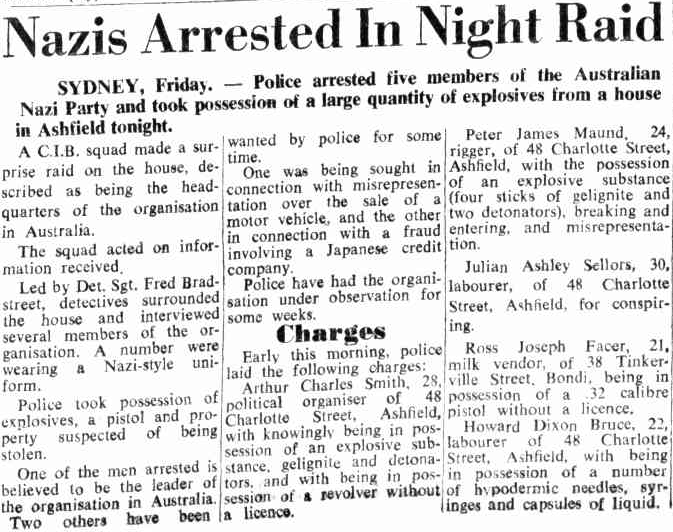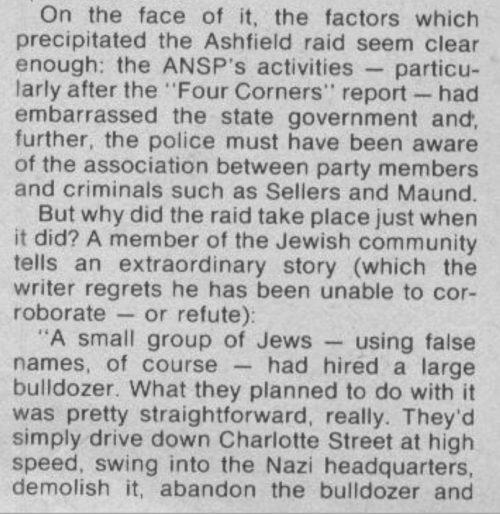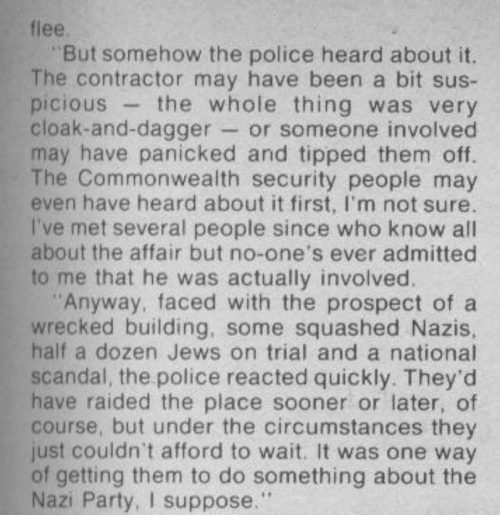Remembering the 43 Group
Marcus Bennett
Tribune
November–December 2018
When 24-year-old Morris Beckman returned to his house on Amhurst Road in Hackney, he’d experienced quite a lot. His time fighting fascism abroad had seen him survive two Nazi torpedo attacks on a British Navy ship in the Atlantic. While his relieved mother showered him with affection on his return home, his father’s message was rather starker: ‘The bastards are back,’ he warned.
Indeed, the London that Beckman returned to fell far short of the expectations of himself and millions of other ex-servicemen. Though it may run counter to the popular narrative of the triumph over Hitler, fascism grew rapidly in Britain immediately following the Second World War. Fascist prisoners interned during the war began to reorganise their crippled movement, while a new presence of captured Nazi soldiers being released from prisoner-of-war camps and into British society prompted a far-right renaissance.
Within months of the war’s end, fourteen fascist groups and at least three bookshops operated openly across the city. Newspapers with names like Britain Awake and The Patriot were readily available on street corners. Most alarmingly of all, fascists began staging outdoor rallies in the densely-Jewish East End once again. ‘Openly in the streets you had public meetings shouting out the same antagonism and the same filth as before the war,’ commando veteran Jules Konopinski recalled, ‘and now even worse — they were saying the gas chambers weren’t enough.’ Alarm spread among the Jewish community that anti-Semitism could find a foothold so soon after the defeat of the Nazis.
Emergence
Nowhere was alarm at the situation felt more strongly than in Maccabi House, a Jewish sports club in Hampstead. Morris Beckman recalled that the club had a ‘subdued ambience’ that reflected the ‘weariness and uncertainties’ of the times. Polish-Jewish veterans of the Allied forces with no families or homes to return to were forging friendships in a new city. Several pre-war Maccabi regulars died fighting Hitler. The ones that had survived, once awash with optimism, were now world-weary veterans who mixed uncomfortably with jovial teenagers who hadn’t served.
In those days the true enormity of the Holocaust wasn’t known, and as the full picture began to emerge it had a profound effect on the community. Jewish ex-servicemen in particular carried a ‘sick sense of shame’, Beckman said, that no Allied action had been taken to prevent Nazi operations in the death camps. This consciousness was emerging at the same time as walls in London — whose Jewish community had only escaped the fate of their European neighbours by geographical quirk — were once again being daubed with swastikas.
To many, it felt as if Britain hadn’t learnt a thing. The Truth, a magazine whose editor, Colin Brooks, was a close confidante of Daily Mail owner Lord Rothermere, called for Jews to give up their houses to ‘British’ ex-servicemen. In October 1945, thousands signed an ‘anti-alien’ petition in Hampstead which called to expel the area’s large Jewish refugee population.
In February 1946, while driving for a pint in Hampstead Heath, four young Jewish ex-servicemen — the former Hurricane ace Alec Carson, Gerry Flamberg, Len Sherman, and Morris Beckman — witnessed a rally by the British League of Ex-Servicemen and Women, the organisation of Jeffrey Hamm. A familiar face of pre-war fascism, Hamm was interned for his loyalty to Hitler and was now seeking to rebuild Oswald Mosley’s movement. Addressing a sixty-strong meeting, Hamm chose his words carefully, denouncing the ‘aliens in our midst’ who ‘waxed fat in the black market’ while British soldiers died.
Pretending to buy a copy of Britain Awake, Sherman abruptly knocked two fascists unconscious by banging their heads together. Flamberg toppled the makeshift stage and knocked Hamm over. As the crowd scattered, an elderly German Jew stayed to shake their hands. It occurred to all four that they could face serious charges for their actions. ‘Well then,’ Carson said, ‘it’s about time they change the laws.’
Their action was widely supported, and an organising meeting at Maccabi House was arranged to push back the fascist threat. Thirty-eight ex-servicemen and five women turned up. The vast majority were Jewish, but the group also included non-Jewish socialists like Joe Zilliacus, a former Marine and son of left-wing Labour MP Konni Zilliacus. What united them was their conviction that the Jewish community must not be passive in the face of provocations.
Alec Black, a veteran of the D-Day landings, proposed establishing an organisation that could effectively fight fascism and anti-Semitism. He knew this would be a serious endeavour and emphasised that everyone involved would risk serious harm and jail time. Anyone feeling nervous about this activity could leave without any judgement or prejudice against them. No one moved an inch or said a word.
The organisation had two aims: to prevent fascist activities by physical force if necessary, and to pressure Parliament into making racial incitement a criminal offence. Since those present had few motivations beyond completing the tasks at hand, no grandiose names were suggested. It was decided they would be called ‘The 43 Group’, after the number of people in the room. But, by April of that year, the name seemed misplaced; over 300 people had bolstered the Group’s ranks.
Confrontation
After encountering their first post-war instances of physical resistance, London’s fascists dropped their respectable veneer. Rather than hiding behind dog-whistle phrases, the seasoned repertoire of Hitler salutes, ‘Heil Mosley’ chants, and renditions of the Horst Wessel Lied, the Nazi anthem, returned. In the face of constant physical attacks in their communities and workplaces, fascist anger grew increasingly frenzied. A bomb was pushed through the door of Gerry Flamberg’s home, while two 43 Group commandos beat unconscious a young fascist who had stitched razorblades into a flat cap and charged through Stamford Hill slashing people’s faces.
In November 1946, 43 Group militants published a letter in the Jewish Chronicle appealing for further assistance. It inspired a swell in members, but provoked an angry response from Louis Hydelman, who sat on the Board of Deputies of British Jews. Accusing the young commandos of acting ‘counterproductively’, Hydelman ordered the Group to disband. His intervention only highlighted the divide between young Jews committed to tackling the fascist presence and the older communal leadership, who remained legalistic in outlook.
Hydelman’s letter, derided for its patronising tone, fell on deaf ears. The Group’s impressive infrastructure, convinced members they could afford to ignore their critics. Not only could they boast of an active base of 1,000 members, but they had also made influential friends. Left-wing Labour MPs such as D.N. Pritt, John Platt-Mills, and
Woodrow Wyatt were keen supporters, while entertainment giants Jack Solomon and Bud Flanagan regularly donated significant sums to the organisation.
On the streets, confrontations intensified. Tightly-organised 43 Group units would form human ‘wedges’ at rallies, pushing through fascist security to attack the stage, and use ‘supporting parties’ to heckle and break up fascist proceedings. On Sunday, 1 June 1947, these skirmishes came to a head in Ridley Road, a market area of Hackney known for its vibrant Jewish life. The fascists’ decision to demonstrate here was particularly provocative as it had been a favoured site of Mosley’s British Union of Fascists in the 1930s.
The 43 Group organised for the ‘Battle for Ridley Road’ with military precision. Commandos were given maps of the surrounding streets with entry and exit points for ambush attacks. But walking up to the platform they were still taken back by the size of the far-right crowd. With police backing too, the fascists hugely outnumbered the 43 Group. But they nonetheless infiltrated the audience in front of the stage and, when fascist leader Alexander Raven Thomson began to speak, started heckling.
‘Going back to the Isle of Man for your holidays?’ one commando shouted. (Thomson had been imprisoned in a detention camp on the Isle of Man during the war.) ‘They should have hanged you with William Joyce!’ said another. Then the wedge struck and ferocious fighting broke out. A description of scenes by Morris Beckman recalls the intensity.
A young fascist about eighteen years of age appeared in front of me and called me a ‘Fucking Jew bastard’, catching my left thigh with a nearly well-aimed kick. I hit his nose square on and it spurted blood … I kicked his backside as hard as I could and he staggered off. A hard blow landed smack on my right ear and completely unbalanced me. For a moment, I was dazed, disorientated. My assailant was about to close and finish me off when Sam grabbed him around the neck and pulled him to the ground. Then Sam jumped on him. The genial, good-humoured Sam said, ‘I’m just breaking the bastard’s ribs so he won’t attend any more meetings.’
Victory
Ridley Road was the high point of a two-year period where the 43 Group had broken up around fifteen fascist meetings a week. The exhaustion of the original core Group members was evident, and younger comrades arrived to replace them. Jules Konopinski, who fled Poland in 1939, lost nine aunties and uncles in the Holocaust. His uncle, an Auschwitz survivor, moved to London to live with him, and was the ‘eyewitness evidence’ of the Holocaust he needed to motivate him in the fight against fascism. Alongside his friend Vidal Sassoon, an apprentice hairdresser whose attitude was that ‘after Auschwitz, there were no more laws,’ he became a militant; both of them armed with scissors, scrunched-up newspapers, and fisticuffs.
With a new layer of youth rejuvenating its ranks, the Group felt a sense of impending victory. Broader political developments were encouraging. Printworkers’ unions began to refuse to print fascist material, while both workers and union officials pressured the government to take action against Mosley. Widespread confrontations during the 1948 May Day rally broke the organisational backbone of the nascent Union Movement, which had amalgamated many fascist groups. 43 Group spies within fascist circles reported that, in drunken moments, Mosley’s ardent followers bitterly bemoaned the unpopularity of their leader, as it began to dawn on them that their days of glory were over.
Exhausted but satisfied that an immediate threat had passed, the 43 Group disbanded in April 1950. Following the war, bomb-marked Britain, Reynolds News noted, was the ‘only country in Europe, outside of Spain or Portugal, where one may preach undiluted fascism with full police protection.’ The 43 Group offered uncompromising resistance to Hitler’s would-be successors in Britain. Hardened by their experiences, they managed to close down the majority of post-war fascist meetings. During his retirement, Vidal Sassoon recalled that the 43 Group symbolised the moment that London’s Jews ‘turned their cheek for the last time.’ Their struggle should be remembered.
See also : Hidden Histories #6: “Fight Fascism Now!” — The 43 Group, Daniel/politicscurator, Medium, May 3, 2018 | Anti-fascist Hackney: The 43 Group – in their own words, the radical history of hackney, April 12, 2018 | hatful of history blog on 43 group | The 43: Story of how UK Jews fought a wave of post-war anti-Semitism to be subject of new TV series, Cahal Milmo, The Independent, October 2, 2015 | The 43 Group, Morris Beckman (1993).
Bonus STRAYA!
A few years after The 43 Group smashed Mosley & Co, on the other side of the worlde the ‘Australian National Socialist Party’ had set up shop in the Sydney suburb of Ashfield. In 1964, ABC’s 4 Corners dedicated an episode to the party and its fuehrer, Arthur Charles Smith. Shortly after the episode screened, the nazi headquarters was raided by police. Even more interesting, in David Harcourt’s classic 1972 text Everyone Wants to be Fuhrer: National Socialism in Australia and New Zealand, it’s claimed that the police raid was to avoid the embarrassing prospect of the site being demolished by angry Jews. As detailed elsewhere in the book, this actually happened a few years later in Melbourne, when an angry mob demolished a similar venue: on Sunday, January 31, 1971 a crowd of anti-fascists (including many Jews, members of the Maoist Worker-Student Alliance and others) descended on the headquarters of the National Socialist Party of Australia and proceeded to smash it. (Below : ‘Nazis arrested in night raid’, The Canberra Times, June 27, 1964; extracts, Everyone Wants To be Fuehrer …)
NB. Ross ‘The Skull’ May features in Harcourt’s book. ‘The Skull’ actually ran as an NSPA candidate against Gough Whitlam for the seat of Werriwa in 1974 (gaining 82 votes/0.1%), as an independent in 1975 (263 votes/0.4%) and in 1977 (1,079/1.6%). A few years ago, he was adopted as a mascot for the short-lived neo-Nazi group ‘Squadron 88’ in Sydney. The group’s leader, ‘Mark McDonald’, has since become the lvl boss of ‘The Lads Society’ in Sydney, and its headquarters in Ashfield is a grim reminder of a previous nazi occupation (albeit one with a happy ending).




